Once, I decided that I really needed a suspension point at home. I live in an old building in St. Petersburg, and my ceiling is 3.60 meters high. One morning, I came home, grabbed my drill, took the prepared anchor, drilled a hole, screwed in the anchor, and hung a rope. I tugged at it. Seemed fine. Then, like a true experimenter testing everything on myself, I hung from the rope. I’m a pretty big guy, and I was already like that back then. The rope held. “Well,” I thought, “let’s conduct the final tests.” I hung on the rope and climbed up, reaching the ceiling and touching it with my hand… and at that very moment, the anchor popped out, along with the dowel.
I, along with the rope, anchor, dowel, and myself, fell down. I crashed to the floor like a sack of potatoes, hitting my head hard. After that, I stood up, shook it off, told my future wife something like, “Well… clearly, that didn’t work,” and headed off to work.
This wasn’t my only failed experiment with a suspension point. I’ll tell you about another one sometime.
From that, I concluded that suspending myself from a single point in a house with a ceiling made of thick plywood is not the best idea.
And let me tell you now—remember this well: making a full suspension point on a single anchor anywhere is not worth it. Concrete, you know, crumbles. The load during suspension, whatever its vector, always goes “outward” on the anchor. The load during suspension is always dynamic. Not to mention that the anchor can simply unscrew. Are you ready to bet your partner’s health on the strength of concrete and a single anchor? That’s a rhetorical question, reader.
In Nikita’s studio, where I started my bondage journey long ago, there was bamboo suspended from three anchors.
Three anchors with a distance of 80-100 cm between the outer ones and bamboo/rings suspended from them is probably the simplest safe option. Specifically three; more than that doesn’t make sense. I worked with such a setup for several years, and it was good. You just need to monitor the condition of the anchors and the concrete/bricks around. Tighten the anchors, use various “liquid nails” on the concrete, and so on.
So what to do if your ceiling is like mine? What to do if you want to suspend but there are no points and you can’t just make them?
Calm down, reader, I’ll lay it all out for you.
Let’s start with chairs and tables.
Until I had a proper point, I worked on chairs. It looked something like this:

I don’t have a photo of the actual suspension, but I think you can guess what it looked like.
The setup is extremely unstable; you have to work carefully. You can choose not to tie the bamboo to the backs of the chairs but simply lay it between them.
Yes, it’s like the joke about “very low,” yes, it’s not very convenient, yes, it’s unstable, and you need to understand what you’re doing. But… in the absence of a better option, reader, you make do with the simple.
Another tip: try to perceive the chair as a structure of irregular shape. And then you will immediately understand that you can lay it on its side or on its back.

Next, I came up with two anchors on the wall. It looked something like this:
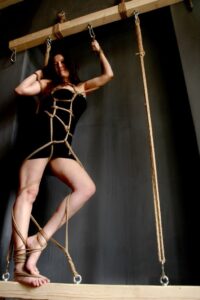
The niche I have in the wall saved me, meaning there was more space. Still, face-down or face-up suspensions are not very comfortable. Sideways is excellent. And generally, if you just need to secure for spanking or other fun, it’s the perfect option. Such fixation easily conceals itself.
The nuance here is that you need to choose the thickest anchors you can find; otherwise, they will just bend.
Okay. I recommend it.
Unfortunately, I couldn’t find a photo with the table. But, I think you understand, reader, that you can basically suspend from a table. The table should be sturdy, preferably made of solid wood. And you need to be mindful of the weight distribution so that the table doesn’t tip over. If you can manage with chairs, you can certainly handle a table.
Here’s another interesting, non-obvious option: working on a chain.

For this, you’ll need a couple of strong anchors in the walls at a height of 160-180 cm from the floor (this positioning hides them even better), and of course—a chain. You can do all sorts of things with a chain. Tie, suspend… Well, you’ll figure it out. It’s an extremely workable option. Just choose thicker anchors and chains, and make sure that the rope doesn’t get pinched between the links.
For a while in St. Petersburg, everyone worked in doorways; I didn’t have that experience, but I had a window that was 220 cm high and 120 cm wide.

It’s also a workable option, albeit dangerous. You can’t do much here. But the very fact of working in a window can be an interesting point. You can do it, if you’re careful.
Now, if you find yourself without chairs, tables, and two wires hanging from the ceiling where a light bulb will once hang, go outside. You go outside and find that there are simply no thick, low branches.
But there’s a trunk:

A trunk is quite good. You can and should work with a trunk, considering that it’s both dirty and rough. I could never make anything delicate on a trunk. But painful options worked really well.
Now let’s talk about various “mounting platforms”:

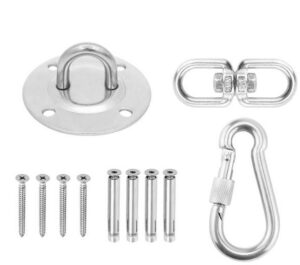
I’ve never liked such options. One, I’m afraid, won’t be enough. And if you need more, why not hang three simple anchors? In general: either not enough or too much. I have no experience working with such things specifically because of that.
Hooks. There are anchor rings, and there are anchor hooks.
Here’s another story:
This happened at the first Moskow Knot, where I was a bit of a translator from English to Russian swearing.
So, Ricardo approached me and began to enthusiastically explain with all his Italian temperament that the hooks screwed into the suspension frame are dangerous and he doesn’t want to work on them. He asks for help hanging a ring. In the end, I think everyone worked on rings, while I worked on a ring with WykD Dave.
And rightly so.
You can secure yourself to hooks, but suspending on them is categorically not advisable. I even remember avoiding securing myself. Just look at what condition those hooks were in after a dozen bindings.
In conclusion, dear reader, here’s a real rarity.
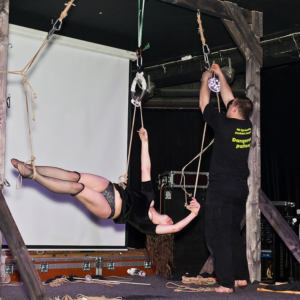
I still have my notebook from 2011-2012 where I planned all sorts of things.
Here are a couple of photos from it:
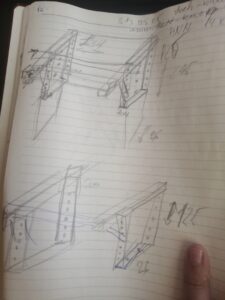
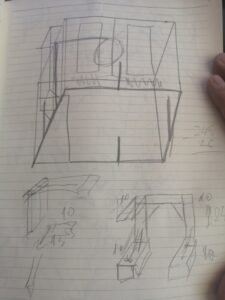
I was thinking about making something at home to suspend a person. I considered various options for frames, channels, and everything else. As you can see, I’m not much of an artist.
The option numbered 1, I even tried to implement. I twisted everything, hung a beam, and tried to hang from it. You should have seen how I fell from there on my very first try, along with all the wood that was twisted there!
I got hit on the head by a 10×10 beam.
And it was after these attempts that this design was born, which faithfully served me for three years.
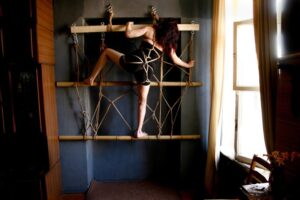
So, for today, my lonely random reader—that’s all.

